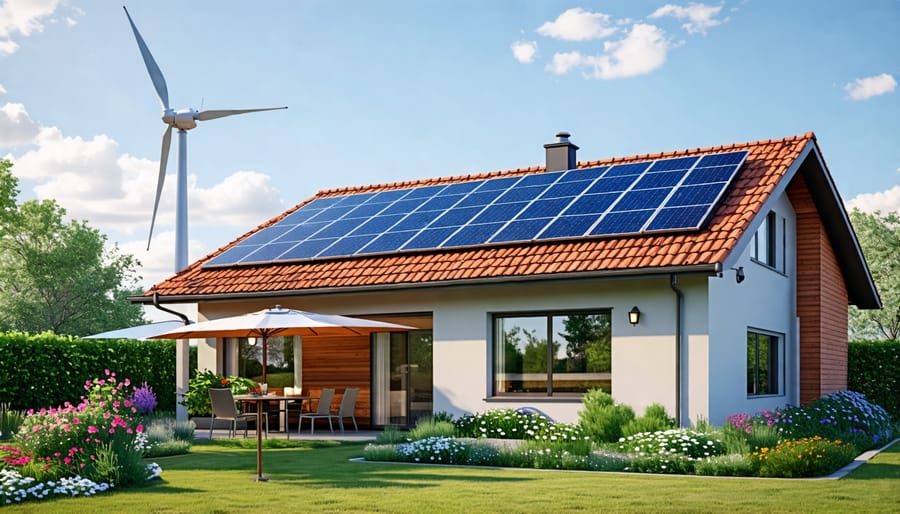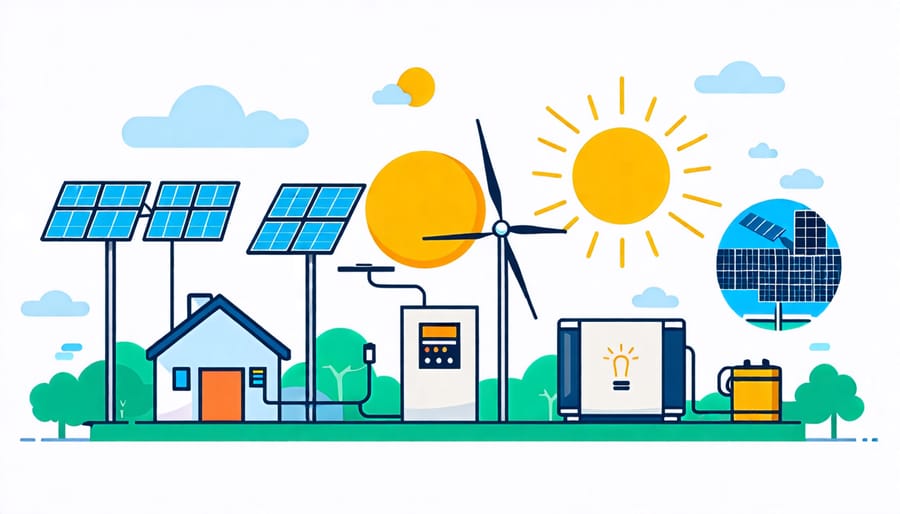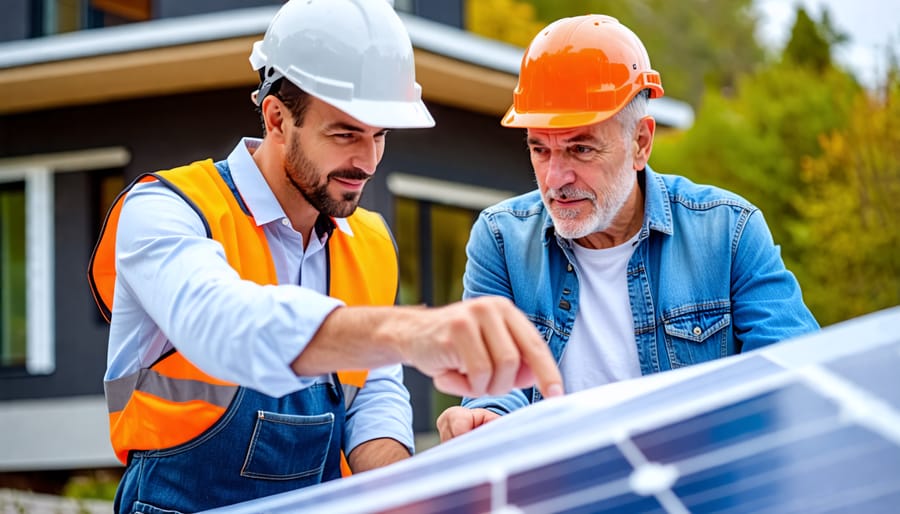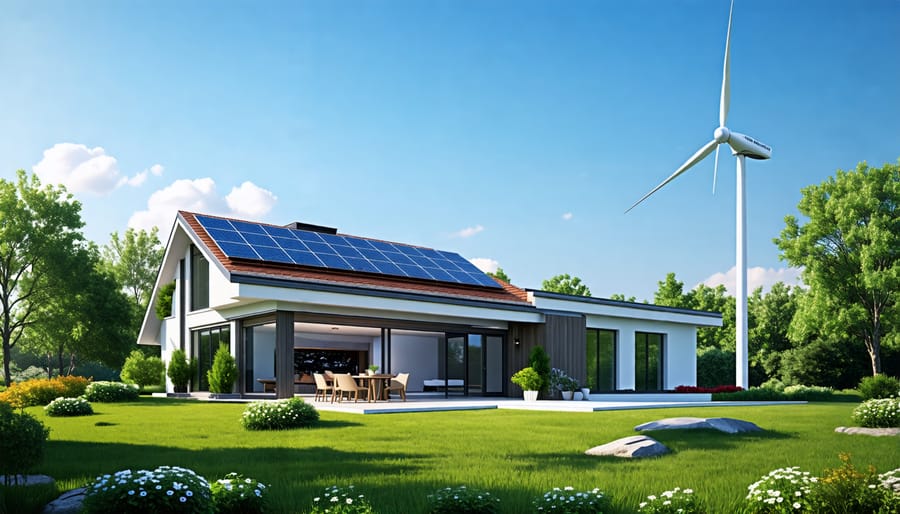Harness the power of nature and embrace energy independence with a solar and wind hybrid system for your home. By combining these two clean energy technologies, you can reduce your reliance on the grid, lower your carbon footprint, and potentially eliminate your electricity bills. A well-designed hybrid system optimizes the strengths of both solar and wind power, providing a reliable, sustainable energy solution that adapts to changing weather conditions. With falling costs and advancing technology, there has never been a better time to invest in a solar and wind hybrid system and become part of the clean energy revolution.
How Solar and Wind Energy Work Together

Solar Energy Basics
Solar panels harness the sun’s energy by converting photons into electricity through the photovoltaic effect. When sunlight strikes the panels, it excites electrons within the solar cells, generating direct current (DC) electricity. This DC power is then converted into alternating current (AC) by an inverter, making it usable for household appliances. Solar panels work best in direct sunlight, with optimal conditions being clear, sunny days. Factors such as panel orientation, tilt angle, and shading can affect their performance. To maximize efficiency, panels should face the sun’s path and be positioned at an angle that optimizes exposure based on the location’s latitude. While solar panels can still generate some electricity on cloudy days, their output is significantly reduced compared to optimal conditions. By understanding these basics, homeowners can make informed decisions when integrating solar energy into their hybrid systems.
Wind Energy Fundamentals
Wind turbines harness the kinetic energy of moving air to generate electricity. As wind flows over the turbine blades, it causes them to spin, driving a generator that converts this mechanical energy into electrical power. Wind turbines require a steady supply of wind at sufficient speeds, typically above 7-8 mph, to operate effectively. Factors such as wind speed, air density, and the swept area of the blades influence the amount of power a wind turbine can produce. Modern wind turbines are designed to optimize energy capture and can generate electricity in a wide range of wind conditions. By strategically placing wind turbines in areas with strong and consistent wind resources, such as hilltops, open plains, or offshore locations, we can maximize their clean energy output and contribute to a more sustainable future.
Components of a Solar and Wind Hybrid System
A solar and wind hybrid system for home use consists of several key components that work together to harness renewable energy and provide reliable power. At the heart of the system are solar panels, which convert sunlight into electricity through the photovoltaic effect. These panels are typically mounted on the roof or in an open area with ample sun exposure. Wind turbines, another essential component, capture the kinetic energy of moving air and convert it into electricity. The size and number of wind turbines depend on the site’s wind resource and energy requirements.
To store the energy generated by solar panels and wind turbines, the system relies on batteries. Deep-cycle batteries, such as lithium-ion or lead-acid, are commonly used due to their ability to withstand repeated charging and discharging cycles. The stored energy in the batteries can be used during periods of low renewable energy production or at night.
Charge controllers play a crucial role in regulating the flow of electricity from the solar panels and wind turbines to the batteries. They prevent overcharging and ensure optimal battery performance. Maximum Power Point Tracking (MPPT) charge controllers are highly efficient, as they continuously adjust the load to maintain the maximum power output from the renewable energy sources.
Inverters are responsible for converting the direct current (DC) electricity produced by the solar panels, wind turbines, and stored in the batteries into alternating current (AC) electricity. AC power is the standard form of electricity used in homes for appliances and electronic devices. Inverters come in various sizes and types, such as string inverters, microinverters, and hybrid inverters, each with their own advantages and suitability for different system configurations.
Other components that enhance the functionality and safety of a solar and wind hybrid system include grid-tie equipment for connecting to the utility grid, battery management systems for optimal battery performance, and monitoring devices for tracking energy production and consumption. By carefully selecting and integrating these components, a well-designed solar and wind hybrid system can provide a reliable, sustainable, and cost-effective energy solution for homes.


Designing and Sizing Your Hybrid System
Energy Audit
Conducting an energy audit is a crucial step in determining your household’s electricity requirements before designing a solar and wind hybrid system. Begin by gathering your utility bills from the past year to calculate your average monthly and annual energy consumption in kilowatt-hours (kWh). Next, make a list of all the electrical appliances and devices in your home, noting their power ratings and estimated hours of use per day. This information will help you identify the major energy consumers and potential areas for efficiency improvements.
Consider using an electricity usage monitor or smart meter to gain more accurate, real-time data on your consumption patterns. These devices can reveal hidden energy drains and help you make informed decisions about energy conservation measures. Additionally, assess your home’s insulation, air sealing, and ventilation to identify opportunities for reducing heating and cooling loads, which can significantly impact your overall energy requirements.
By thoroughly understanding your household’s energy needs and implementing efficiency measures, you can optimize the size and design of your solar and wind hybrid system, ensuring it meets your electricity demands while minimizing costs and environmental impact. A well-conducted energy audit forms the foundation for a successful and sustainable renewable energy solution tailored to your unique home and lifestyle.
System Sizing
To properly size a solar and wind hybrid system for your home, you’ll need to assess your energy consumption and the renewable resources available at your location. Start by reviewing past utility bills to determine your average daily kilowatt-hour (kWh) usage. Next, evaluate your site’s solar and wind potential using tools like the National Renewable Energy Laboratory’s (NREL) PVWatts Calculator and Wind Prospector.
Based on this data, you can estimate the number and size of solar panels and wind turbines needed to meet your energy needs. As a general rule, a 1 kW solar panel array generates about 4-6 kWh per day, while a small residential wind turbine (1-10 kW) can produce 5-20 kWh daily, depending on wind speeds.
It’s crucial to strike a balance between solar and wind components to ensure consistent power generation. In most cases, a 60-40 or 70-30 split between solar and wind is optimal. However, the exact ratio will depend on your site’s specific conditions.
When sizing your system, consider factors such as future energy demands, battery storage capacity, and costs and savings over the system’s lifetime. Consulting with a professional installer can help you fine-tune your system design for maximum efficiency and reliability.
Installation and Maintenance
Installing a solar and wind hybrid system for your home can be a complex process, but with the right guidance and resources, it is achievable. Homeowners have two main options: professional installation or a DIY approach. Professional installers have the expertise to design and install a system tailored to your specific needs, ensuring optimal performance and safety. They handle all aspects of the installation, from obtaining permits to connecting the system to the grid. While more expensive upfront, professional installation offers peace of mind and long-term reliability.
For those with the necessary skills and knowledge, a DIY installation can be a cost-effective alternative. This requires a thorough understanding of electrical systems, local building codes, and the components involved. DIY enthusiasts must carefully plan the system design, obtain the necessary permits, and follow best practices for safety and efficiency. Online resources, forums, and workshops can provide valuable guidance for those pursuing this route.
Once installed, solar and wind hybrid systems require ongoing maintenance to ensure optimal performance. Regular tasks include cleaning solar panels, inspecting wind turbine blades, and checking electrical connections. Monitoring system output and addressing any issues promptly helps maintain efficiency and longevity. Many professional installers offer maintenance plans, which can be a convenient option for homeowners. By staying proactive with maintenance, you can maximize the benefits of your renewable energy investment for years to come.
Case Studies and Success Stories
John and Sarah, a couple from Arizona, decided to install a solar and wind hybrid system in their home to reduce their reliance on the grid and minimize their carbon footprint. After working with a local installer to design a system that met their energy needs, they now generate over 90% of their electricity from clean sources. “Our monthly utility bills have decreased significantly, and it’s incredibly satisfying to know that we’re doing our part to combat climate change,” Sarah shares.
In rural Oregon, Mark, a retired engineer, took on the challenge of designing and installing his own solar and wind hybrid system. By carefully sizing the components and optimizing the system’s efficiency, he has achieved complete energy independence. Mark enjoys sharing his knowledge with others in his community, hosting workshops on sustainable living and renewable energy.
The Patel family in New Jersey opted for a solar and wind hybrid system when renovating their home. They worked closely with their architect and a renewable energy consultant to seamlessly integrate the technology into their home’s design. “Not only have we reduced our energy costs, but our home has become a conversation starter and an inspiration for our neighbors to consider clean energy options,” Mr. Patel explains.
These success stories demonstrate the tangible benefits of solar and wind hybrid systems for homeowners across diverse regions and lifestyles. By embracing this innovative technology, families are not only saving money and reducing their environmental impact but also contributing to a growing movement toward a cleaner, more sustainable future.
Conclusion
In conclusion, solar and wind hybrid systems offer a promising solution for households seeking to reduce their carbon footprint and achieve energy independence. By harnessing the complementary nature of solar and wind energy, these systems provide a reliable, efficient, and clean source of power. The benefits are numerous, from lower electricity bills and increased property value to the satisfaction of contributing to a more sustainable future.
While the initial investment may seem substantial, the long-term savings and environmental benefits make solar and wind hybrid systems an attractive option for many homeowners. As technology continues to advance and costs decrease, these systems are becoming increasingly accessible to a wider range of households.
If you’re considering making your home a greener home, exploring solar and wind hybrid systems is a great place to start. By conducting thorough research, consulting with experts, and evaluating your specific energy needs and location, you can determine if a hybrid system is the right fit for you. With the right system in place, you can enjoy the benefits of clean, renewable energy for years to come while contributing to a more sustainable future for our planet.





